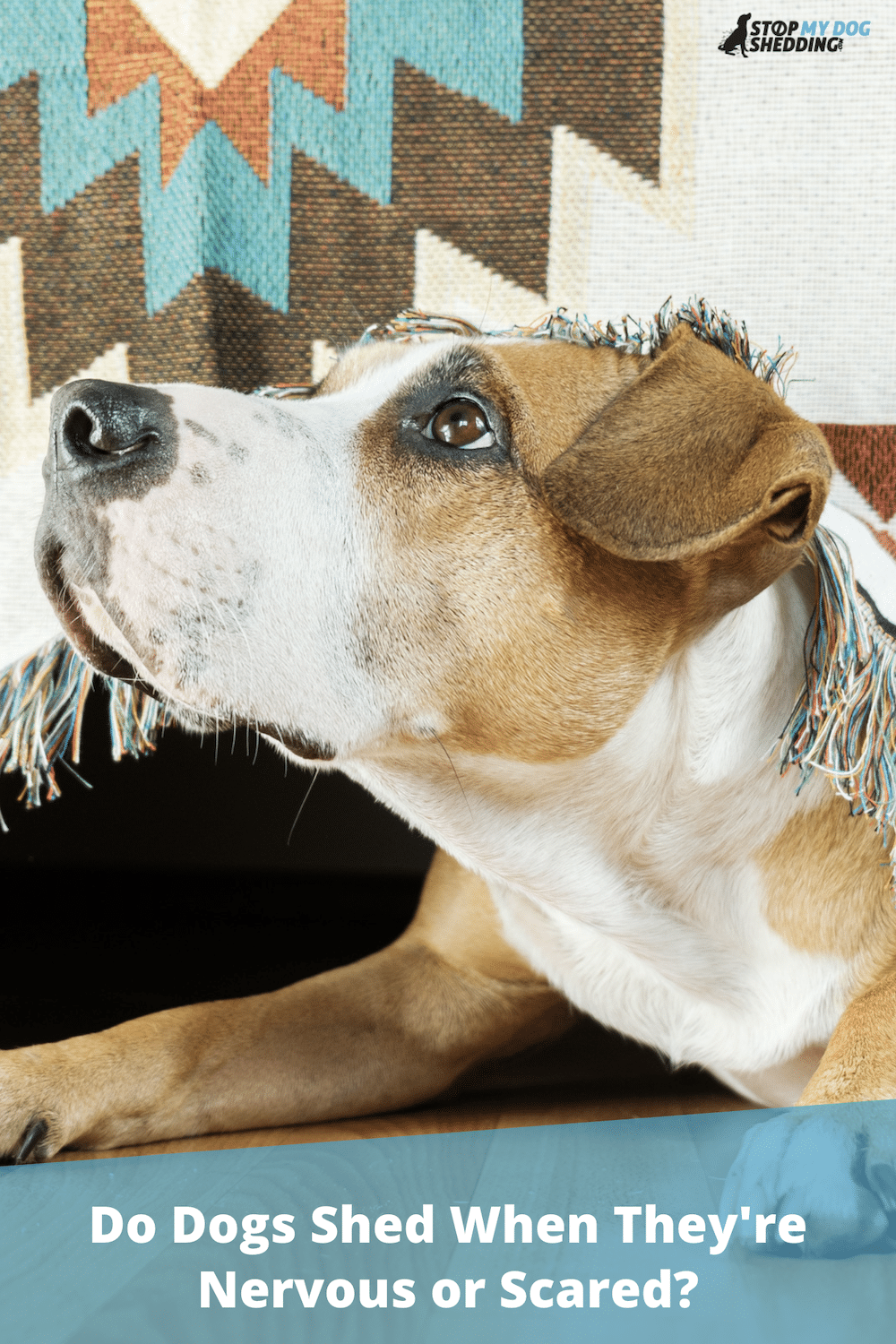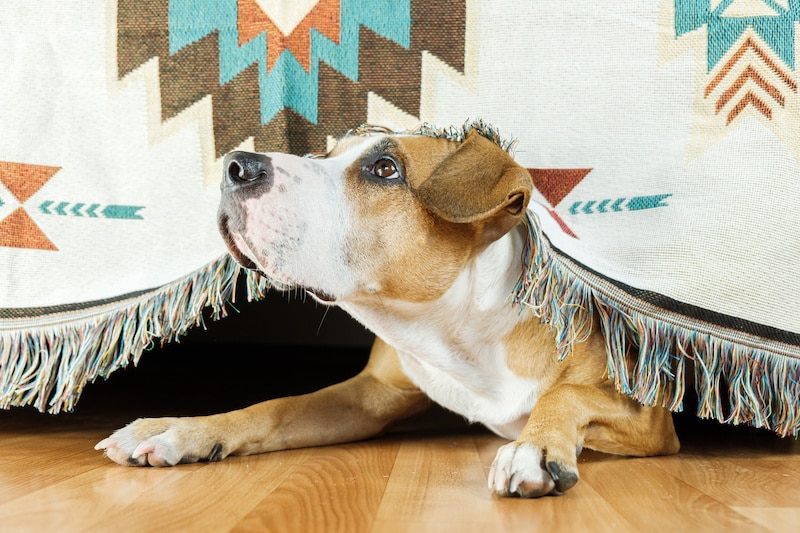You’ve heard of scaredy cats, but not “scaredy dogs.”
Yet, that’s precisely what some dogs are. So if your dog gets nervous when a stranger rings the doorbell, thunder leaves him terrified, and you’re noticing hair all over the home, then you may be wondering if the fear and shedding are somehow connected?
Well, the truth is that, yes, anxiety in dogs can cause them to blow their fur more often. The reason this happens is due to a spike in adrenaline, which causes the hair to come out.
To control anxious shedding, you have to understand what triggers your dog’s anxiety, then limit exposure or help them overcome it.
And in this article, I’ll walk you through some of the most common anxiety triggers and provide you with some tips on what to do about anxiety-induced shedding.
Recommended: Go here to see our top-rated dog hair blow dryers
Do Dogs Shed More Often When They’re Anxious? Why?
For the most part, dog shedding is perfectly normal.
Some dogs shed heavily because they’re double-coated. When the seasons change, these dogs release fur to prepare for warmer or colder days ahead. Other dogs frequently shed because their hair growth cycle resets faster than average.
However, if your dog isn’t known for heavy shedding and it suddenly starts happening, you shouldn’t ignore the issue. Shedding can be indicative of a health issue.
For example, your dog’s diet could leave them nutritionally deficient and make them shed more, he could have a skin allergy or condition that leads to hair shedding, or it could be something else entirely. So if you have any concerns, I recommend speaking with a qualified veterinarian.
That said, excessive shedding can occur if your dog is nervous, scared, or stressed.
That’s right; we people aren’t the only ones who experience stress in our day-to-day lives. Our four-legged friends can feel stress as well.
While dogs don’t stress out over looming bills or mean bosses, they do have their own unique set of stressors that can leave them in an anxious spiral. I’ll talk more about those in the next section.
It is widely accepted among experts that anxious or scared dogs will shed. You might see this at the dog park or the veterinarian’s office. The backseat of your car will be covered in fur. Even show dogs can shed ahead of a big competition.
What causes the shedding?
It’s a hormonal reaction.
Just like we have a fight or flight response that kicks in at perceived signs of danger, so do dogs. During the fight or flight response, the body is flooded with adrenaline.
Adrenaline can make people feel impervious to pain, at least for short periods, which is supposed to aid in your survival. Yet, in dogs, it causes their hair to shed.
Although experts aren’t quite sure why adrenaline causes this reaction, what’s clear is that it certainly does happen.
In some instances, your dog might react to anxiety or fear by ripping its fur out or licking an area to excess, both of which would also lead to hair loss. In most cases, though, it’s a hormonal reaction.
Anxiety-induced shedding is not a big deal if your dog generally isn’t exposed to scary situations very often. However, for pups that have chronic stress, such as those who spent a long time at a shelter, then the shedding issue can be more significant.
Most dogs that experience shedding due to fear or stress will calm down once they’re no longer exposed to the stressor. It can be hours to days before the excess shedding ceases.
What Makes Dogs Stressed?
Now that you understand the connection between stress and shedding in dogs, you’ll want to minimize all sources of stress for your pup in the future, so they never lose any hair unnecessarily.
As great as that would be, it’s impossible, as many of the things that stress out dogs are unavoidable. Here’s a list of possible triggers so you can see what I mean.
Moving
Moving is a perfect example of how you can’t erase all sources of stress from your dog’s life.
For some people, they find the home of their dreams and stay there forever. Many more people, though, bounce from home to home before settling in. Census.gov estimates that the average person can move about 11 times!
Each time you put all your possessions in moving boxes and rent a U-Haul, you’re creating stress in your dog.
Some dog owners are so consumed in all the frenzy of moving that they don’t even notice their four-legged friend isn’t acting like it usually does. Instead, they might assume their dog just needs to adapt to their new surroundings.
That will happen with time, but until then, expect more shedding from your dog.
Bringing a New Person or Pet into the House
Another unavoidable source of stress is growing your family.
Whether you have a baby, adopt a child, or a family member or friend moves in, growing the human members of your family can make your dog cautious and anxious at first.
Bringing new pets into the house–be those dogs, cats, or other critters–can also stress out your pup.
Vet Appointments
Arguably the most significant source of stress for any dog is going to the vet. They don’t like being handled by strangers and being poked, prodded, and squeezed.
Seeing other pets can upset them too.
The best solution for healthy dogs that only need an annual checkup is to grin and bear it. Your dog must see the vet, so you’ll deal with cleaning up the extra dog hair for a few days.
If your dog is especially upset and scared about the prospect of a vet appointment, you could always research vets that do home visits. That might alleviate some of your dog’s anxiety.
Loud Noises
Whether it’s a car backfiring, a clap of thunder, someone in the house dropping a pan on the floor, or fireworks on Independence Day, your dog is distressed by all sorts of loud sounds.
You try to keep it down in your own house, but you can’t help what other people do. All you can do is turn up the TV and hope it drowns out some of the outside sounds for your dog.
Separation
Does your pup suffer from separation anxiety? The longer the issue goes unchecked, the more severe it can be. Separation anxiety can cause your dog to have accidents in the house and even destroy household objects.
Your Stress
If your dog is always upset and you can’t pinpoint why; consider your own stress levels. Dogs are very receptive to our moods. That’s the case when you’re happy as well as when you’re sad.
If you feel high-strung and tense because of a looming work deadline or a personal issue, your dog could react in kind by shedding.
Signs Your Dog Feels Anxious
How do you know your dog is anxious or stressed? They’ll manifest certain symptoms. Here are some of the signs to be on the lookout for.
Eager to Escape or Hide
Your dog does not want to be in a stressful situation if they can help it. They’ll try to wriggle their way out of it, whether that’s turning tail at the dog park or slipping out of their leash at the vet’s office. When you find your canine companion again, they could be hiding.
Avoidance Behaviors
If your dog refuses to make eye contact when they’re usually very responsive, this can mean they’re stressed. This is generally accompanied by other avoidance behaviors such as licking, sniffing the ground, or otherwise disengaging from the situation.
Increases or Decreases in Bodily Functions
Your pup usually has a very healthy appetite, but now they don’t want to eat. They also had two urinary messes today. These bodily control shifts are indicative that your dog is feeling stressed.
Panting
Panting must be assessed contextually. For example, if you just took your dog for a walk and they’re panting, that’s because they’re hot, not stressed (more than likely). However, if your dog is panting on a cool day after no physical exertion, then it’s likely because they’re afraid of something.
Physical Changes
Look at your dog’s posture and face as well to confirm their fear. They might cower or otherwise try to make themselves look small. Their body can go stiff, and their tail will be tucked between their legs.
Your dog’s ears will flatten, and their eyes will become very large and white too. This is because adrenaline can dilate your dog’s pupils.
Drooling or Yawning
Although these seem like relatively mild side effects, they are symptoms of stress, nevertheless. You’ll notice an increase in yawning as well as lots of drool from your dog, usually from the excessive licking a dog can exhibit when stressed.
Barking and Whining
Listen to your dog for signs they’re stressed. They may begin whining and crying or even barking to get your attention and tell you how they’re feeling.
Shedding
Although most dogs drop at least some hair, if the shedding is more severe and accompanied by some of the things mentioned earlier, it could be a manifestation of the dog’s stress.
How to Relieve Anxiety in Your Dog and Reduce Their Shedding
No one likes to see their four-legged friend suffer. So if you’re noticing fear-induced shedding, the following methods can lessen their anxiety and thus control how much hair they blow out.
Limit Exposure to Stressors
Now that you know the signs of stress in dogs, watch how your dog behaves in their everyday life. For example, is it loud noises that stress them out? Your new cat? The dog park?
For many of these stressors, you can minimize your dog’s exposure.
For instance, if you know your pup doesn’t do well at the dog park, then play with them in your enclosed yard with just you and them.
If fireworks upset your dog, then consider staying home on Independence Day so you can monitor your dog. Instead, consider turning on your television and providing them a safe, comfortable, and quiet place to hide.
Keep a Regular Routine After a Stressful Change
As I mentioned earlier, some stress in your dog’s life is inevitable. After enduring a scary situation, be that a move to a new house or a trip to the vet, don’t put your pup through further stress for a while.
Create a sense of routine and follow a predictable schedule. This will make a big difference in your dog’s stress levels!
Socialize Your Dog Early
By socializing your dog, you’re exposing them to people, places, animals, and situations. And as they see slices of life play out, they realize that everything is not as scary as they perceived. That’s why the younger your dog is when you socialize them, the more prepared they’re likely to be when it comes to handling life’s changes.
Recommended: Go here to see our top-rated dog hair blow dryers
Bottom Line
Shedding is a normal, healthy thing that almost all dogs do. However, as I’ve explained in this article, dogs can shed excessively from stress and anxiety.
The key is to understand what is upsetting your dog in the first place. And once you’ve identified the culprit, it’s all about taking steps to reduce the stress so that you can reduce the shedding. By doing this, you’ll have a happier dog, and there’ll be less fur floating around your home.
For more tips, check out our complete shedding guide. And as always, if you are concerned about your dog’s hair loss, speak with your local veterinarian. Because sometimes, there can be an underlying health issue, and in that case, your vet will be the best person to speak to.













Please note: By submitting a comment using the above comment form, you confirm that you agree with the storage and handling of your data by this site as detailed in our Privacy Policy.